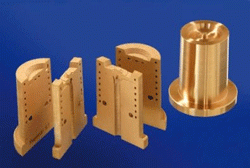SLM components made from copper alloy powder open up new opportunities
March 9, 2011

Tool insert with internal cooling channels
made from copper-base alloy Hovadur®
K220 using selective laser melting (SLM)
technology. (Courtesy: Fraunhofer Institute
for Laser Technology ILT)
As has recently been reported in the ipmd.net e-newsletter (17th February and 12th January 2011) selective laser sintering is a rapidly growing production process particularly suitable for metal components of complex shape that cannot be manufactured using conventional technology or can only be produced at very high cost.
The process involves building up a 3D workpiece, layer-by-layer, on a platform using fine metal powders or powder alloys. Directed by computer-generated design data for the planned workpiece, the metal powder is deposited in layers and then sintered at the required points by a laser beam. As a result, each layer bonds with the previously deposited layer building up the structure.
Tests have shown that steel or light-metal components produced in this way exhibit the same mechanical properties as conventionally produced metal parts. However, because of the high thermal conductivity of copper and copper alloys, it has not been possible until now to use SLS for these materials. Copper has a lower melting point than steel and it also exhibits lower laser light absorption and higher heat dissipation. As a result, the powder melts interrupting the track, and tiny balls of molten metal form. This creates cavities in the component and thus reduces its final density.
Researchers at the Fraunhofer Institute for Laser Technology (ILT) in Aachen, Germany have succeeded in overcoming technical problems that have, until now, prevented the commercial use of selective laser sintering (SLS) for copper alloys by developing a variation of SLS called ‘selective laser melting’ (SLM). The successful new SLM process is a result of funding provided to the Fraunhofer ILT team by the German Federal Ministry of Economics and Technology (BMWi) for an ‘InnoSurface’ research project.
The Fraunhofer ILT team, led by project manager David Becker, compensated for the high heat dissipation and the low laser light absorption by the copper alloy during the melting process, by using a 1000-watt laser instead of the 200-watt laser that is currently the norm in SLS. Dr Becker stated in a recently published report that in order to achieve satisfactory results, a laser was chosen that produces a particularly even beam profile. Additionally, the inert gas control system and the mechanical equipment was modified to prevent the higher energy input from causing disruptions. Becker said that tests with the copper alloy Hovadur K220 were already showing excellent results with workpiece densities reaching almost 100%.
One application of the new technology involves the production of copper alloy inserts used in steel injection moulding tools for the manufacture of plastic parts. The SLM inserts ensure rapid heat removal from the moulding tool at critical points. SLM makes it possible to integrate conformal cooling channels into these copper inserts to carry a coolant such as water. Injection moulding cycle times and warping are reduced by fast and even cooling of the entire tool. Fraunhofer ILT is also planning to use pure copper powders to make dense components. The thermal conductivity of pure copper is almost twice as high as Hovadur K220.
Contact: [email protected]
News | Articles | Market reviews | Search directory | Subscribe to e-newsletter















